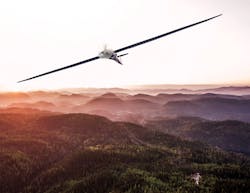Long-flight-time unmanned systems serve as invaluable data-gathering tools for tactical intelligence, surveillance, and reconnaissance (ISR) missions, and the Air Force Research Laboratory (AFRL) set new endurance standards for an unmanned aerial system (UAS) as part of its Ultra Long Endurance Aircraft Platform (Ultra LEAP) program.
Testing performed by the AFRL’s Center for Rapid Innovation (CRI) demonstrated two-and one-half days flight time for an Ultra LEAP UAS at Wright-Patterson Air Force Base, Ohio, with subsequent testing seeking to investigate even longer flight endurance levels for the UAS.
The long flight time makes the Ultra LEAP UAS a strong candidate for extended ISR missions. The unmanned aircraft consists of a commercial airframe converted to a fully automated system with autonomous takeoff and landing capabilities. The UAS includes secure navigation using a jam-proof GPS receiver with full global access. The unmanned aircraft also employs a satellite-based command and control system and high-data-rate ISR relay link for rapid transfer of sensitive surveillance details.
“As the Air Force balances current readiness with long-term modernization, Ultra LEAP represents an affordable approach that supports both existing and future force needs,” said AFRL commander Major General William Cooley.
According to Paul Litke, the AFRL project engineer leading the Ultra LEAP development efforts, the use of many commercial-off-the-shelf (COTS) components helps control costs without compromising performance: “Developing a UAS with this level of endurance is an incredible achievement for future warfighting and battlefield success.”
The high level of automation translates into reduced operator training requirements, less learning time needed to train operating crews, and lower operating costs compared to less automated unmanned surveillance aircraft. The system could be ready for fielding as early as 2020.
About the Author
Jack Browne
Technical Contributor
Jack Browne, Technical Contributor, has worked in technical publishing for over 30 years. He managed the content and production of three technical journals while at the American Institute of Physics, including Medical Physics and the Journal of Vacuum Science & Technology. He has been a Publisher and Editor for Penton Media, started the firm’s Wireless Symposium & Exhibition trade show in 1993, and currently serves as Technical Contributor for that company's Microwaves & RF magazine. Browne, who holds a BS in Mathematics from City College of New York and BA degrees in English and Philosophy from Fordham University, is a member of the IEEE.
